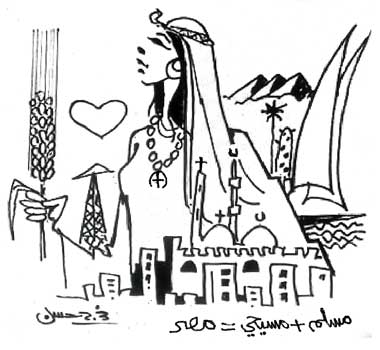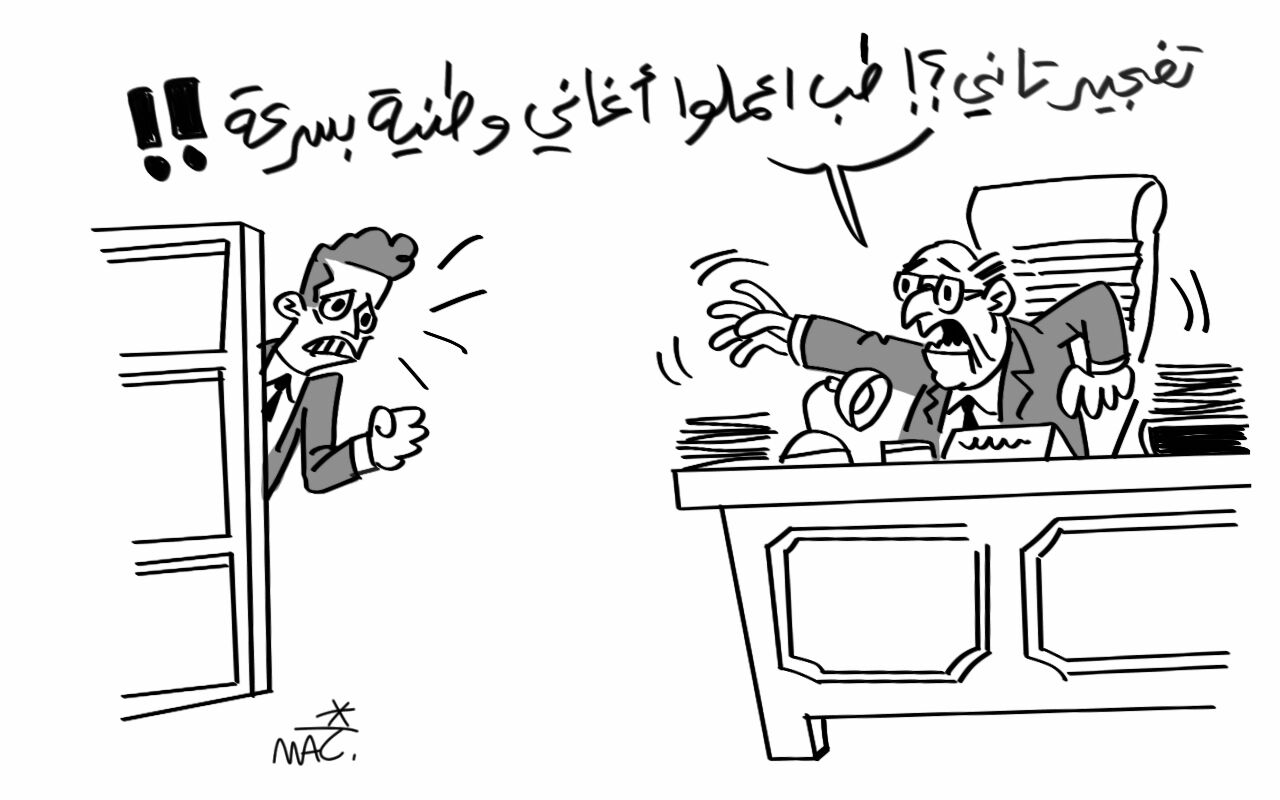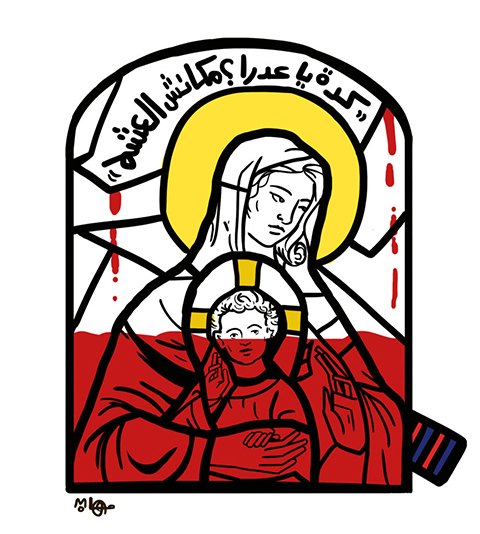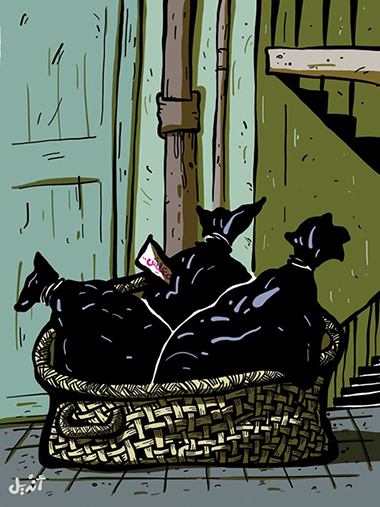December 16, 2016
Cartoonists for Egyptian newspapers regularly draw in the wake of a tragedy. On December 11, a suicide bomber attacked attacked St. Paul and St. Peter Church, leaving 25 dead and 50 injured. While Egypt has experienced targeted assassinations, attacks on police outposts, and a plane crash in recent times, the strike on the Coptic churches was the most drastic example of targeting civilians in the capital. How would illustrators react to the brazen act of terror?
In spite of the dwindling space for dissent in Egypt, independent cartoonists harshly criticized the government’s response. Cartoonists for privately owned newspapers often go father than columnists or reporters in lambasting the government’s misdeeds. Even I was surprised by their boldness this week as they penned provocations in the shadow of terrorism and as President Abdul-Fattah El-Sisi sought to allay fears about the targeting of Egyptian Christians. Meanwhile, in government-run newspapers, there were strong expressions of solidarity with Egypt’s Christians and absolute support for the state.
The duty of the cartoonist is to push the reader beyond the normal scope of contemplation, to offer a joke, jab, or insight. That is exceedingly difficult in the midst of national mourning. These five cartoons about the heinous attack offer a variety of perspectives on terrorism, violence against Christians, and fissures within Egypt today:
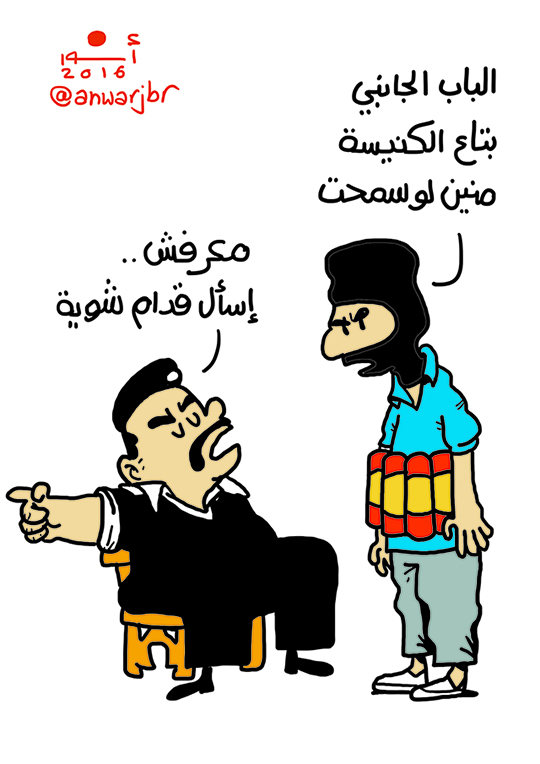 (Anwar, Al-Masry Al-Youm, Dec. 13, 2016)
(Anwar, Al-Masry Al-Youm, Dec. 13, 2016)
“Where is the nearest entrance of the cathedral, sir?” asks the masked bomber.
“Not sure. Ask a bit farther up,” replies the slouching police officer.
This cartoon exemplifies the audacity of humor in face of tragedy. Anwar, an independent cartoonist for the country’s most widely circulated private newspaper, skewers the authorities incompetence. He directly blames the police for not thwarting the attack, for not providing necessary protections to the country’s Coptic minority. In recent years, Anwar has drawn many stinging indictments of the security forces.
(Farag Hassan Al-Ahram, Dec. 15, 2016)
This cartoon appeared in Egypt’s flagship state-run newspaper Al-Ahram and thus closely mirrors the president’s message of hope and courage. Mother Egypt stands upright above church and mosque, with the Great Pyramids of Giza and a traditional Egyptian sailboat (felucca) in the background; the glamorous Cleopatra signals defiance of terror.
Below it reads a simple equation: “Muslim + Christian = Egypt.” This equation is exclusionary (what of Egypt’s non-Christian religious minorities, like Jews or Bahai, are they not part of the country?). It also obscures the systematic and institutional discrimination that Egypt’s Coptic minority is subject to. “Egypt’s Christians do not share in equality of citizenship,” writes Michael W. Hanna, a fellow at the Century Foundation in Public Orthodoxy. He goes on to detail the de facto and de jure biases against the religious minority. Hanna’s takeaway is striking: “A state and society that tolerates and normalizes bigotry and sectarianism will also engender more malicious expressions of that hatred.” It’s a message, he notes, that goes far beyond the Egyptian context.
Cartoons like the above, however, seek to paper over such difference and advance a warm and fuzzy narrative of unity. Also of note: In traditional Egyptian editorial cartooning, Egypt is frequently depicted as a woman, implicitly saying that her honor must be protected. This topic demands wider investigation given the prevalence of such tropes in the mainstream media and is the subject of an excellent historical study by scholar Beth Baron.
(Makhlouf, Facebook, Dec. 11, 2016)
The evening after attack, the cartoonist Makhlouf posted a piece of gallows humor on his Facebook page. “Another explosion?! OK then, prepare a nationalist song — quick!!” yells an official to his assistant. Makhlouf alludes to the attack, two days prior, on a police checkpoint near the Giza Pyramids, which killed six officers. Importantly, the cartoonist is serving as an ombudsman, reminding his readers that no anthem can eclipse the authorities’ failures.
The government often flexes its nationalistic muscles in times of tragedy. The funeral for Church bombing’s victims was no exception, and many observers have lambasted the state’s politicization of bereavement. “Watching the ceremony on television, one could scarcely escape the impression that the relatives of the martyrs were of only secondary importance compared with the tightly interwoven array of military, state and church officials who dominated the scene,” writes scholar Paul Sedra in a close reading of the ceremony.
(Mohab, Mada Masr, Dec. 12, 2016)
The photos of the attack’s aftermath were harrowing, almost biblical—bloodied scenes of a holy space. In an arresting remembrance of the martyred, the independent artist Mohab illustrates a bloodstained stained-glass window. The text reads, “At last, O Virgin? There is no hope.”
(Andeel, Mada Masr, Dec. 13, 2016)
Also on the independent online news outlet Mada Masr, Andeel drew an oblique image. In a typical scene of a Cairo apartment building, a pile of garbage bags waits outside a doorway. Look carefully and there is a small note that reads, “Maalesh,” an Egyptian word for “I’m sorry” or “Excuse me,” and sometimes also “whatever.”
In this image, Andeel reminds readers that garbage collectors in Egypt are known to be Christian, a role that they have played since the 1930s. The punch line—the small note that says “Maalesh”—indicates the hallowness the country’s condolences or apologies following the attack. Once the reader understands the implied meaning there, there is no qualms about it: The cartoon suggests that Christians take out the country’s trash, a thankless job of the underclass.

